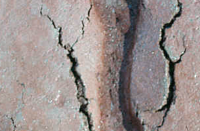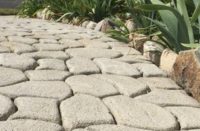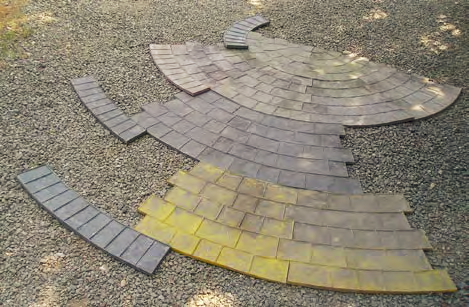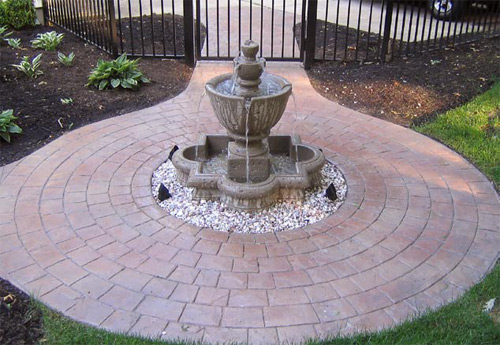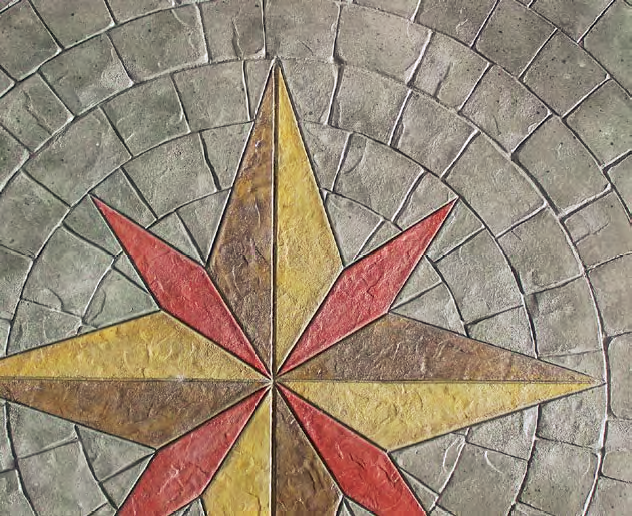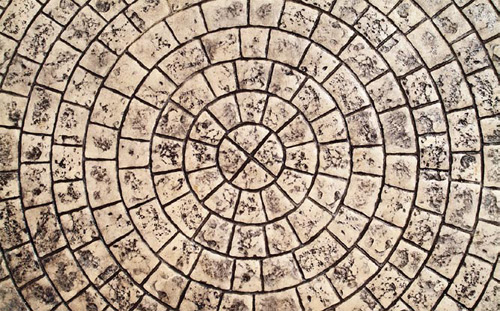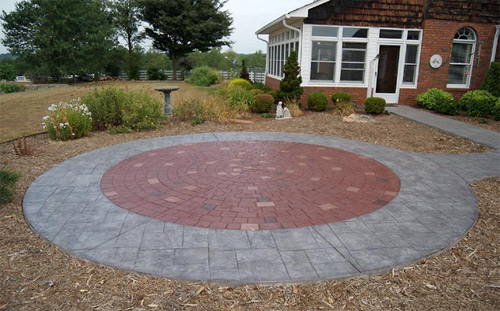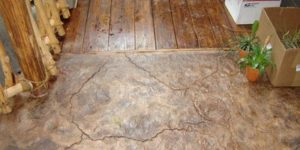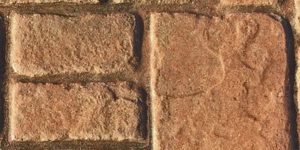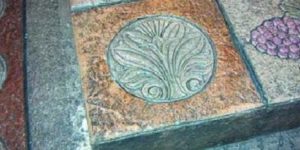Well-rounded decorative concrete contractors are learning the benefits of having a radial stamp kit in their stamping tool collection. Made up of urethane pieces crafted to fit snugly together to form consistent circles, the stamps can be used to create interesting focal points for everything from large expanses of concrete on commercial lots to modest residential patios in backyards.
“Contractors looking to differentiate themselves from the rest of the market are using these stamping tools to help them do that,” says Keith Boudart, sales manager for Butterfield Color, a company that earlier this year introduced its first radial stamp.
The technology has been around for years, he allows, but people these days are realizing that innovative tools can help them pick up more work by offering customers new options at affordable prices. “These patterns are being used along with color hardener to accent broom-finished driveways and patios.”
Contractors just discovering the many applications of radial stamps are often impressed with the elegant results, says Kris Kaitanjian, senior vice president of Matcrete, a company that’s been manufacturing them since 1984. “They produce a rich appearance that looks as if each cobblestone was hand-cut and fit for that one job,” he says of his stamp.
As noted, the stamps themselves are not circular, but rather sets of curved pieces that when fit together form filled circles, half circles or round decorative borders. They can also be used to place tiered circles of larger sizes surrounding a basic circle pattern, which would typically be between 4 feet and 5 feet in diameter. For added flair, a couple of companies offer a compass point as a central design element in their radial design.
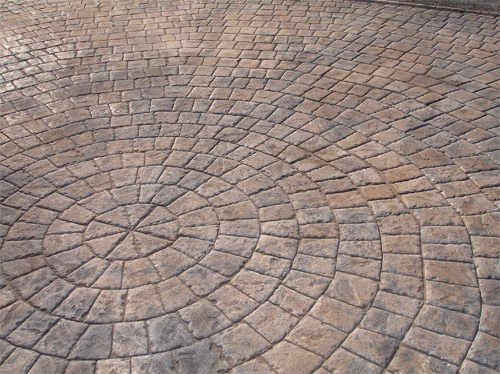
diameter and larger. The set is comprised of five different stamping tools. | Photos courtesy of Proline Concrete Tools Inc.
Finally, some radial stamp sets can be used to form serpentine designs and other curvy design elements as well as circles.
At World of Concrete 2010, Proline Concrete Tools Inc. introduced a revolutionary new design in radial stamps. The company’s European Cobble Series of five different stamping tools can be configured to create circles from 5 feet in diameter to as large as you want to go. You also can use the individual pieces to create a running bond cobble, a serpentine cobble, a mixed cobble or a band by rearranging like stamps or combining different stamps.
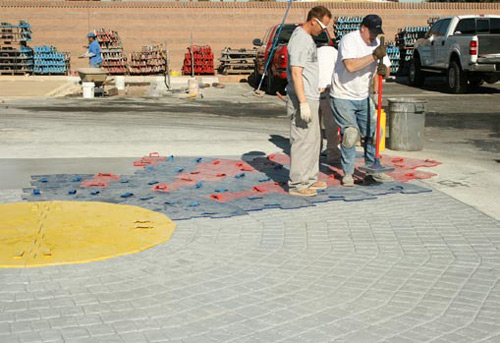 “Our radial stamps have been received extremely well,” says Tyler Irwin, Proline’s national sales manager. “Contractors like the fact they can make endless circles without having to buy a new set for each row of stamps.” The stamps can be used on new concrete or overlays.
“Our radial stamps have been received extremely well,” says Tyler Irwin, Proline’s national sales manager. “Contractors like the fact they can make endless circles without having to buy a new set for each row of stamps.” The stamps can be used on new concrete or overlays.
The European Cobble Series features a round tool, a curved tool, a half tool, a full tool and a double tool. Proline sells the stamps in suggested sets of 12 or 16, but you can buy fewer.
Four round tools form the innermost circle. Curved tools shape a band that looks like four rows of cobblestone to surround this initial circle. The next tier utilizes curved tools along with half tools all the way around the circumference. Each subsequent tier added requires the additional use of a half tool between the curved tools”
“With this new technology, contractors just need to buy one set of tools to stamp a radius out to infinity because the same set of tools keeps repeating,” Irwin says. “There’s nothing else like it on the market.”
The Proline sales manager says the pattern is very user-friendly and doesn’t require any special training. Contractor Allen Ortiz of Allen Decorative Concrete, in Escondido, Calif., concurs. He says he used the radial stamps for a 19-foot circle in a parking lot. “I didn’t have any specific training (with these tools) and I found it easy. Proline gives you a sheet to show you how to lay them out. They work very nice. You can keep building and building whatever size circle you want. It’s a pretty cool concept.”
www.prolinestamps.com
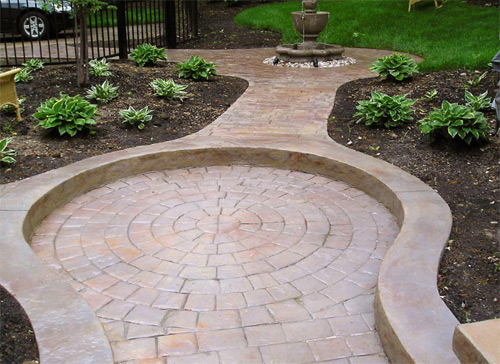
The radial stamp set from Matcrete, part of the company’s Slate Cobblestone series, features a tool that creates a 52-inch cobblestone center. Subsequent tiers can be added to extend the circle out to 9, 14 or 19 feet. The four tools in the series can create circles, half circles and rings on fresh concrete and stampable overlays.
Kaitanjian recommends a minimum of four stamps per tier, for a total of 16 stamps. “If you only have two of each, you’re going to be playing leapfrog,” he says.
A decorative border made from the company’s new brick soldier course line can be used around the perimeter of a 52-inch, 9-foot or 14-foot cobblestone circle as a finishing touch. “This really works well when you want the circle one color and the soldier course another,” Kaitanjian says, adding that the soldier course was designed with hand-cut slate pieces.
Matcrete’s stamps are easy to use, Kaitanjian says. “The stamps interlock and are color-coded so all you need is general stamp knowledge to use them. No specific additional training is necessary. It’s a tried-and-true pattern that’s withstood the test of time.”
In July, Matcrete introduced a new tool that creates a 52-inch-wide compass point. It can be used in place of the 52-inch cobblestone center.
www.matcrete.com
Three different tools make up Butterfield Color’s natural-looking cobblestone circle pattern. They can be used together or separately to form various medallions and borders. Butterfield Color introduced its three-tiered cobblestone circle pattern earlier this year. Crafted from the same hand-picked, variable-sized cobblestones used to produce its Mayan Cobblestone stamp, Mayan Cobblestone Circle features three different tools that can be used together or separately to form a variety of medallions and circular borders on overlays or fresh concrete. The straight Mayan Cobblestone stamp can complement the curved designs.
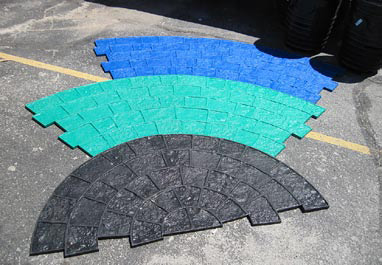
The first tool in the new series can be used to create a circle up to 5 feet wide. The second can extend that circle out to 10 feet. And the third tool can increase the diameter up to 15 feet. Boudart recommends contractors have four of each tool for a set of 12 to comfortably form circles up to 15 feet across.
“Our tools are made to fit tightly together to minimize spreading,” says Boudart. “Also, our stamp pattern is formulated to minimize surface cracking and blowouts along the grout joints.”
Butterfield’s radial tools are designed to be user-friendly for experienced decorative contractors, but training is offered at distributor locations throughout the year. Contractors can also view a demonstration on the company’s website.
www.butterfieldcolor.com
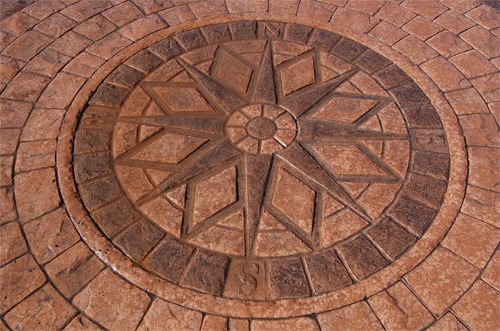
Specialty Concrete Products has been carrying StampMaster radial stamps since it bought StampMaster in 2002. Its collection is comprised of four patterns of radial stamp: Cobble Circle/Course, Slate Radius, Fresh Brick Soldier Course and Fresh Brick Radius. They can be used to make circles on fresh concrete and overlays.
The Cobble Circle radial stamp series – five stamps in all, and the company’s best example of the concept, says marketing manager Robert Cranford – starts with a 52-inch center that can be ringed with another tier to create a 9-foot circle. Around that goes a single row of Cobble Course, followed by another tier of Cobble Circle to create a 14-foot circle. This larger circle also can be ringed in Cobble Course if desired.
A few customers who wanted different-sized circles have approached the company to make custom stamps. “While it’s expensive and time-consuming on our end, it can be done,” Cranford says. “We’re one of the few manufacturers who offer custom stamps.”
The Slate Soldier Course Close Radius and the Fresh Brick Soldier Course Close Radius both consist of a series of three stamps that can be used to create circular rings, half-circle borders and ovals with their respective textures.
Professional contractors will be able to use any of these radial stamps without any problems, Cranford says. “They’re not any harder to use than normal stamps.”
www.scpusa.com
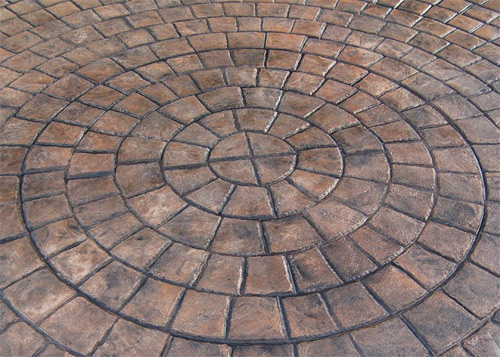
Although Solomon Brickform had been manufacturing radial tools as Brickform for years, the company reworked its offerings and debuted its new cobblestone radial tools at the 2010 WOC. Five new tools in all, the new stamps can produce half – and quarter-round shapes as well as full circles on fresh concrete.
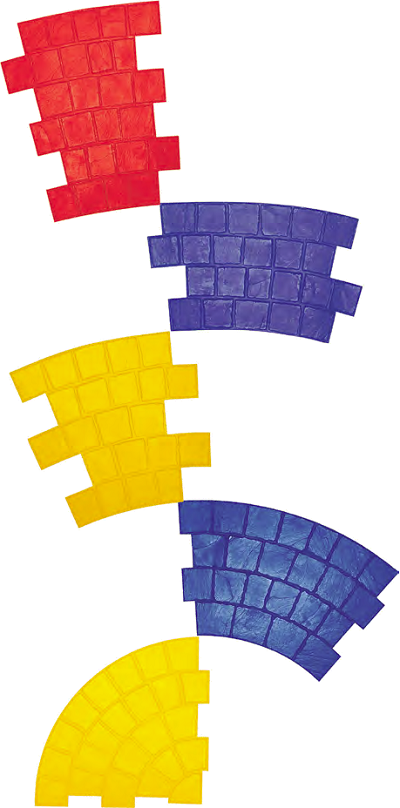 “We took the original stamps and reformulated them so they fit absolutely perfectly with no gaps to create circles from 5 feet to 24 feet in diameter,” says David Blasdel, part of Solomon Brickform’s training and technical team. He adds that the new stamps’ pattern resembles the company’s London Cobble.
“We took the original stamps and reformulated them so they fit absolutely perfectly with no gaps to create circles from 5 feet to 24 feet in diameter,” says David Blasdel, part of Solomon Brickform’s training and technical team. He adds that the new stamps’ pattern resembles the company’s London Cobble.
The next size up from the 5-foot diameter circle is a second perimeter of interlocking stamps that create a 9-foot-wide circle. A third row would carry it out to 14 feet, a fourth row to 18 feet and a fifth row to 24 feet. Blasdel recommends a minimum of four tools per row for a set of 20.
Although Solomon Brickform doesn’t make a border to complement the new series, the company offers fractured-face and cantilevered step liners for raised slabs that can be used to create various looks, including a hard-troweled shiner to a textured-skin stone.
Although these tools are easy to use, Blasdel always recommends training. Solomon Brickform holds three-day training classes every spring and fall in Springfield, Ill., and Rancho Cucamonga, Calif. The company also schedules demonstrations at distributorships across the nation.
www.brickform.com
